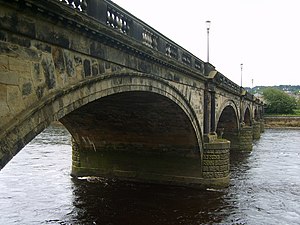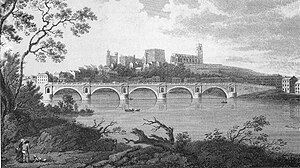Skerton Bridge
Coordinates: 54 ° 3 ′ 16 " N , 2 ° 47 ′ 47" W.
| Skerton Bridge | ||
|---|---|---|
| Skerton Bridge (2008) | ||
| Convicted | A6 (southwards) | |
| Subjugated | River Lune | |
| place | Lancaster , Lancashire , England | |
| construction | Arch bridge made of sandstone | |
| building-costs | £ 14,000 | |
| start of building | June 1783 | |
| completion | September 1787 | |
| planner | Thomas Harrison | |
| location | ||
|
|
||
| Engraving made by John Landseer in 1791 | ||
Skerton Bridge is a road bridge in Lancaster , Lancashire , England that connects the south-facing A6 lanes over the River Lune . The building was placed on the Statutory List of Buildings of Special Architectural or Historic Interest by English Heritage in Grade II * .
history
Towards the end of the 18th century, the old medieval bridge over the River Lune proved inadequate for the increased traffic. A petition has been sent to Parliament to obtain permission to build a bridge in a more accessible location. This decision was made in June 1782 and the competition to design the structure was won by Thomas Harrison , which was his first major contract. The foundation stone was laid in June 1783 and the structure was completed in September 1787. The cost of construction was £ 14,000 (today's prices: £ 1,970,000). In 1839, the bridge was repaired and reground under the supervision of the local architect Edmund Sharpe . An additional arch was added at the southern end around 1849 to enable the crossing of the now disused route of the North Western Railway . The structure still serves as a road bridge today . A review in 1995 found a load capacity strong enough to withstand trucks with a gross vehicle weight of up to 40 tons - about ten times what the heaviest vehicles weighed in 1783.
architecture
The bridge is cut stones from sandstone brick. It consists of five semi-elliptical arches on pillars in the Tuscan style and had a balustrade . This arch shape allowed the structure to run flat. Each of the five original arches has a span of 19.2 m, the clear width between the parapets is 10 m. In the spandrels between the arches and the bridge piers, channels are built in to support the flow of floods. These passages are flanked by Doric pilasters and a gable sits above them .
Connection with other structures
Skerton Bridge was the first major public bridge in England with a level carriageway . At another place it has previously given bridges with this feature, such as 1763 by John Smeaton designed Coldstream Bridge in Scotland and in 1768-74 Neuilly-sur-Seine built Pont de Neuilly by Jean-Rodolphe Perronet , which was canceled 1939th Harrisons influenced John Rennie in his design of the Kelso Bridge (1798-1803), the first Waterloo Bridge (1809-17) and the new London Bridge completed after his son's death in 1824-31 .
supporting documents
- ↑ a b c Skerton Bridge, Lancaster [1212253] ( English ) In: National Heritage List for England . Historic England . Retrieved November 29, 2011.
- ↑ John Champness: Thomas Harrison: Georgian Architect of Chester and Lancaster 1744-1829. P. 17.
- ↑ John Champness: Thomas Harrison: Georgian Architect of Chester and Lancaster 1744-1829. P. 5.
- ^ A b c d Clare Hartwell, Nikolaus Pevsner: Lancashire: North. P. 386.
- ↑ John Champness: Thomas Harrison: Georgian Architect of Chester and Lancaster 1744-1829. Pp. 20-21
- ↑ John M. Hughes: Edmund Sharpe: Man of Lancaster . John M. Hughes, 2010, pp. 166-168.
- ↑ a b c d Skerton Bridge ( English ) Engineering Timelines. Retrieved December 12, 2011.
- ↑ John Champness: Thomas Harrison: Georgian Architect of Chester and Lancaster 1744-1829. P. 19
- ^ A b c Albert Nicholson: Harrison, Thomas (1744-1829) In: Dictionary of National Biography , 1885-1900, Volume 25; on Wikisource
- ↑ John Champness: Thomas Harrison: Georgian Architect of Chester and Lancaster 1744-1829. P. 21
literature
- John Champness: Thomas Harrison: Georgian Architect of Chester and Lancaster 1744-1829 . Center for North-West Regional Studies, University of Lancaster , 2005, ISBN 1-86220-169-2 .
- Clare Hartwell, Nikolaus Pevsner [1969]: Lancashire: North (= The Buildings of England). Yale University Press, New Haven and London 2009, ISBN 978-0-300-12667-9 .


